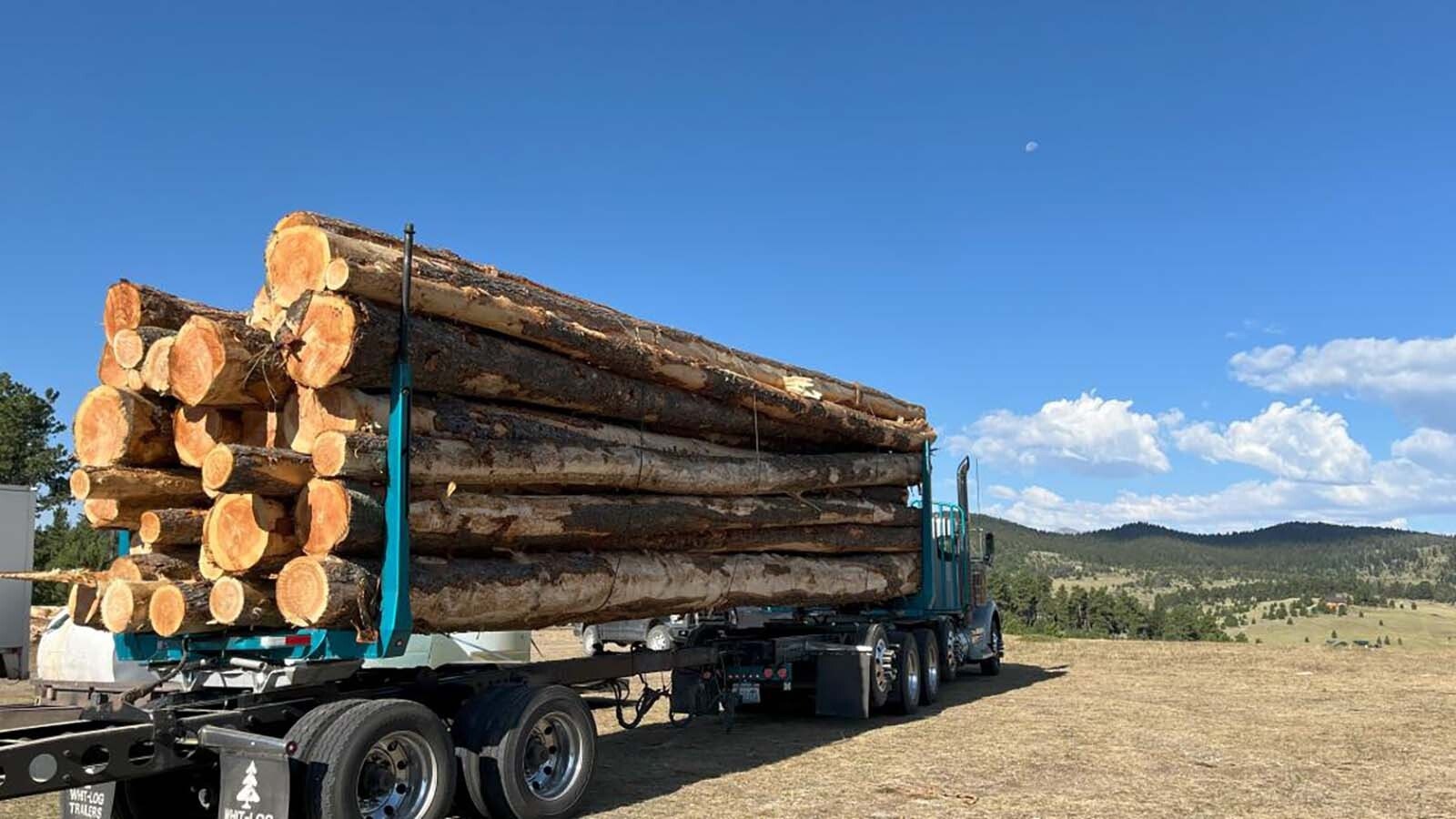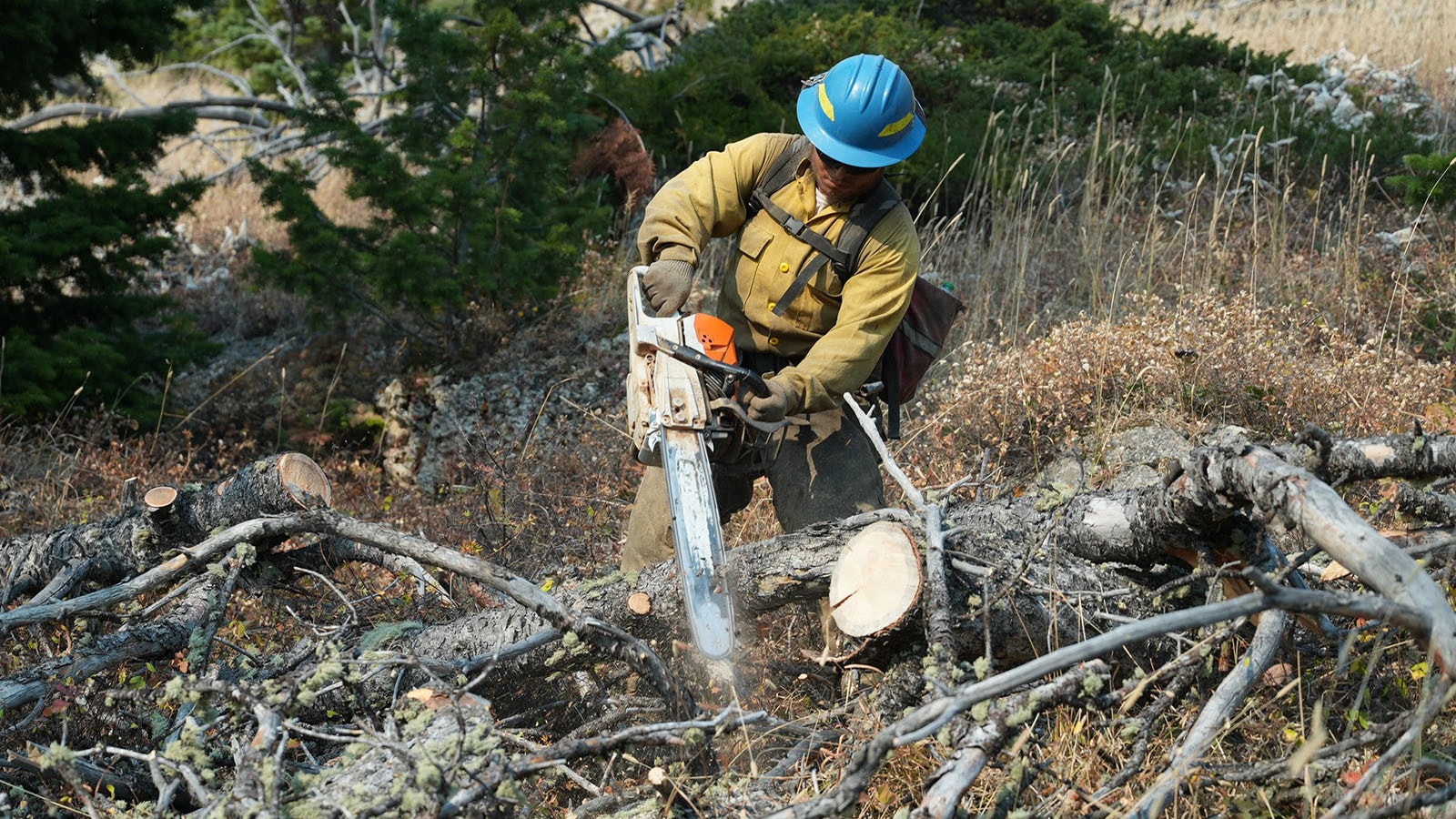Watching the Willow Creek Fire in the Star Valley of western Wyoming, the burning forest ignites a fire of another kind in Jenny Haider’s mind.
It’s a slow-burning internal fire for her, one that’s been smoldering for a long while.
It’s built from years of watching standing dead wood appear in forests where the fourth-generation, family-owned businesses, which she is part of, once helped log and keep clean.
“I would much rather see (that wood) heating homes than just watching it burn and making us all miserable from the smoke in the air,” she told Cowboy State Daily. “And you know people lose their homes or get nervous because they are so close.”
One of those people is Haider’s sister, who was working on building a new house in Star Valley.
“They’re just hoping that the fire doesn’t get any closer to their house than it is,” Haider said. “There’s just a better way to use the resources we’ve been given.”
Haider’s family owns two lumber mills in Wyoming, Smith & Jones Timber and Black Fork Timber. The family business has been going for 80 years, but it almost didn’t survive the last year of the Biden administration.
Haider and her family members are grateful for what the Trump administration and Wyoming Gov. Mark Gordon have been doing to throw a lifeline to the timber industry.
But she fears there’s a good chance it’s going to be too little, too late.
“Everything’s dead,” Haider said. “It needed to be logged and managed a long time ago.”
Her company is finding about half of the additional timber it’s been able to log is dead and unusable. The costs of bringing that timber in, however, aren’t being cut in half.
“The changes are good, and they needed to happen,” she said. “But they needed to happen a long time ago.
“And I hope the Forest Service continues to be proactive, and not just the Forest Service, but the state and everyone else, but it’s almost to the point where they need to pay us to come and haul this dead wood away, because that’s kind of what it’s going to take to make it worth it on our end.”

Dead Wood Makes Bigger Fires
Haider believes that the standing dead wood in so many of Wyoming’s forests is a huge contributing factor in widespread wildfires that have been chewing up the Cowboy State.
More than 850,000 acres burned across Wyoming last year between the Elk Creek, Pack Trail, Fish Creek, Horse Draw, and many other fires.
“That’s why the fires get so bad because everything’s dead,” Haider said. “It needed to be logged and managed.”
Fires in north and western Wyoming have consumed 145,000 acres so far this year, and new fires have blown up in the Star Valley and north of Pinedale.
The Willow Creek Fire has consumed more than 4,300 acres south of Smoot so far and the Dollar Lake Fire north of Pinedale has consumed 13,500 acres.
There’s also the Sleeper Ranch Fire northeast of Meeteetse, listed at 20,600 acres and 90% contained, and the Spring Creek Fire, southeast of Ten Sleep, 95% contained at about 3,600 acres. The state’s largest so far this year is the 125,000-acre Red Canyon Fire east of Thermopolis at 80% containment.
Much of what’s dead and burning right now are beetle-killed forests, Haider said.
“If beetles are starting to get into the forest and you log that right away, you take care of that problem before it takes out your whole forest,” she said. “They want to put up a lot of sales now, which is great, they need to. They need to clean up the forests.
“But there’s still only so many loggers who can go in and log it, and if it’s not worth anything to haul out, it’s hard to do that.”
Haider believes Star Valley communities may be waiting for winter before the fires there will go out.
“Everything is so dead out there,” she said. “And once a fire starts in that dead timber, there’s not much they can do but wait for the rain and the snow to come, because it’s just kindling.”
Serious Ramp-Up Still Needed
Things have reached emergency status for the state’s timber industry, Jim Neiman told Cowboy State Daily.
He owns Neiman Enterprises, a fourth-generation, family-owned business headquartered in the Hulett area. His is one of the state’s last large lumber mills.
“There needs to be a fairly serious, steep ramp-up for us to survive,” he told Cowboy State Daily. “The Forest Service recognizes that, and so does the state.”
Whether it’s going to happen quickly enough is a big question mark weighing on his mind right now.
“Five years ago, I shut down a mill in Hill City, South Dakota, and laid off 125 employees,” he said. “Two and a half years ago, I shut off a shift in Hulett, and not too long after that, I shut off a shift in Spearfish.
“So, our production is down 70% and I’ve laid off way over 200 employees.”
That ramping down wasn’t because his business lacked lumber customers. There were plenty of markets for what he produces.
The supply of timber he could provide from the Black Forest region just kept getting cut, and cut again, by the federal government.
The rationale from previous administrations for those timber sale cuts was always couched in language about forest health.
But Neiman feels as Haider does. That lack of logging is a contributing factor in these large fires that are threatening the communities around national forest lands.
Forests, in Neiman’s opinion, were much healthier before such dramatic cutbacks in logging, because logging helped reduce the fuel available for fires.
Yes, But It’s Complicated
Retired Forester Bill Crapser believes there’s some merit to the idea that more logging could help reduce the size of Wyoming’s forest fires, but it’s more complicated than a simple sound bite.
“It also depends on where the fire is, and what kind of terrain it’s burning in,” he said. “It’s like everything else, it’s easy to say this is what caused it. And it probably is a contributing factor, but it’s probably not the only factor.”
Several areas in Wyoming have difficult terrain, Crapser added, so even with more generous logging policies, there would still be fires and problem areas.
“There’s an awful lot of just dumb luck of where a fire starts and what the weather conditions are when it starts,” he said. “It’s easy to just wholesale say lack of logging is to blame. Or that fire suppression for 100 years is to blame.
“And this isn’t necessarily popular in our state, but personally, I think probably the No. 1 factor in the size and intensity of fires we’re seeing is climate change,” he continued. “Or we can call it extended drought, whatever we want to call it to make it sound better.”
That said, Crapser agreed that lack of proper management does make fire issues much worse.
“Slash that’s left on the ground and everything else,” he said. “There are just a lot of different things involved. I’m all for forest management, and fairly intensive forest management, but we, as a society, love to answer everything in just one sound bite, and it’s much more complex than that.”

Timber Sales Need To Double
The recent increase in sales have been helpful, Neiman said, but are still not at levels high enough to sustain his own operations, let alone the other lumber industries relying on timber from the region.
“There’s a couple of post and pole outfits and a particle board plant that’s owned by Menards that needs a lot of wood,” Neiman said. “There’s an integrated industry here at the Black Hills, it’s not just our operation at stake.”
To get back to an economically viable level of production, Neiman said he and other businesses in the Black Hills area would need to see roughly twice as much timber for sale next year
That timber needs to be high-quality, not just the dead wood that’s been standing around for a while.
“We’re trying to get them back up to a reasonable level that matches the needs of the industry here,” Neiman said. “And I just want to preface, without it exceeding sustainability. We’re not going to do anything that is not sustainable (for the forest).”
Neiman isn’t just working in Wyoming to that end, either. He’s also working with other states like South Dakota and Colorado.
“I’m really seeing strong support from the Wyoming side,” he said. “And we see South Dakota ramping up. We’ve met with the governor of South Dakota, but it’s tough, and we’re just, for instance, having just as big of problems in Colorado.”
Some Of The Jobs Aren’t Going To Come Back
Neiman doesn’t anticipate employment returning to old levels anytime soon.
“The lumber market is there,” he said. “But after wood supply, then your ramp-up is governed by retraining employees. You lose a lot of skilled employees, and our industry is very high-tech, so you’re dependent on really good quality employees.”
Neiman doesn’t believe his employment numbers will ever return to what they were.
“I don’t think we’ll get back to two shifts at both mills at any point in the future,” he said. “We just hope to get Spearfish back to two shifts.”
Haider, meanwhile, is taking it one day at a time, but she believes the robustness of the timber industry is directly correlated to the health of Wyoming’s forests.
“I think people look at logging and they think it’s just major waste,” she said. “But there is zero waste at either of our mills. Everything is usable.”
Even sawdust and wood chips, which are used to make heat pellets that go out to markets in Utah, Wyoming and Colorado.
“That’s a better way to use the resources we’ve been given,” Haider said. “We have to look at logging long-term, because that really is what’s best for our forest and grazing.
“If we graze everything, we don’t have all this dead grass on these dry years that just takes off when these fires hit.”
Renée Jean can be reached at renee@cowboystatedaily.com.





